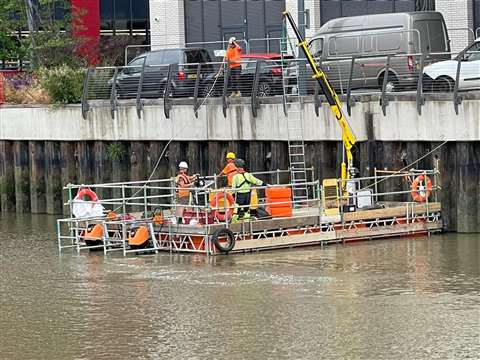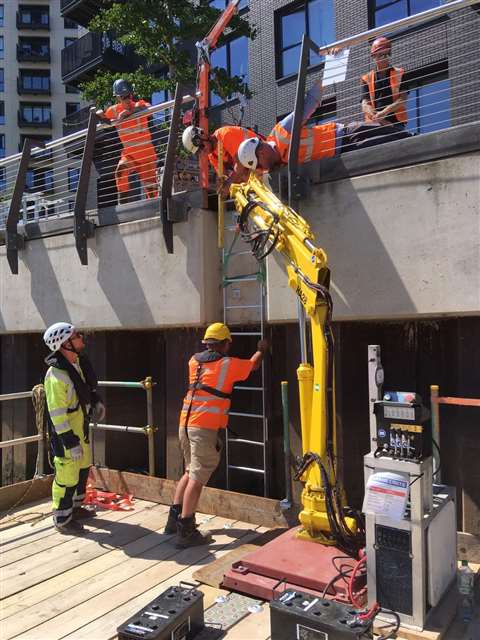Work boat made from scaffolding certified for crane use
22 November 2022
 A 26-foot by 21-foot assembly of standard scaffolding parts on custom floats works on the river Thames installing ladders, fenders and chains. (Photo: ScaffFloat)
A 26-foot by 21-foot assembly of standard scaffolding parts on custom floats works on the river Thames installing ladders, fenders and chains. (Photo: ScaffFloat)
Contractors used a self-propelled pontoon boat made entirely from standard scaffold components and fitted with a crane on the river Thames to install ladders, chains, and wooden fendering.
This project created an evolution of the ScaffFloat system that launched two years ago. The Cornish-based company has grown rapidly across multiple UK markets and adding a crane for the first time to self-powered pontoons for the Thames project has some in the industry comparing the simple, configurable work craft to the popular multicat style workboats.
Configured for the Thames
For the project on the Thames, ScaffFloat mobilized an 26-foot by 21-foot (8m x 6.4m) ScaffFloat fitted with two 60 hp, high-thrust outboards giving 1,800 pounds (0.8 tonne) of bollard pull and a 5-knot service speed. Thirty of the company’s small, patented plastic floats provided the buoyancy to give it a comfortable 5.5 tons (5 tonnes) payload on the large open 538-square-foot (50 square meter) wood deck.
 First use of a knuckle-boom crane on a ScaffFloat deck worked so well the company is working on plans for larger crane platforms. (Photo: ScaffFloat)
First use of a knuckle-boom crane on a ScaffFloat deck worked so well the company is working on plans for larger crane platforms. (Photo: ScaffFloat)
A knuckle-boom crane that can lift 1,300 pounds (600kg) at 16 feet (5m) was fitted to a custom-made steel crane base. This was designed in accordance with Lloyd’s Register Code for Lifting Appliances in a Marine Environment. After NDT testing it was then LOLER tested once fitted to the ScaffFloat, and a full stability assessment was provided in line with relevant International Maritime Organization standards.
The ScaffFloat was also surveyed and licensed by the Port of London Authority as a commercial vessel prior to commencing works.
The ScaffFloat was on hire for almost two months to GPS MACS who are a specialist marine contractor on the Thames. It had the benefit of very low draft (about a foot, or 0.3m) and could be dried out on the steep mud banks giving the workers a much larger tidal working window than more traditional vessels that would not have been able to ground out.
Ross Albertyn, project manager, said “Thanks again for your assistance on this project. The ScaffFloat has been absolutely brilliant.”
Building more capacity
Toby Budd, managing director and founder of the ScaffFloat company said ‘’We started off with simple pontoons that could be used for access. Then we added outboard pods to the pontoons turning them into workboats, suddenly they became much more useful to our customers and now 90% of our hires go out as a ‘vessel’. We then added spud legs, deck winches, and other bolt-ons to add further value. But there is no doubt that it is the addition of a knuckle-boom crane that marks the biggest advance in the system from an engineering perspective. Lifting is a key component for most marine works and I am delighted we can now offer this to our customers’’.
The company is now developing a crane base for larger projects and expects to soon offer a larger crane on a 30-inch (750mm) beam system.
By combining custom plastic floats and standard scaffolding components, ScaffFloat is currently providing highly flexible floating platforms for a wide variety of civil engineering works.
STAY CONNECTED



Receive the information you need when you need it through our world-leading magazines, newsletters and daily briefings.
CONNECT WITH THE TEAM







